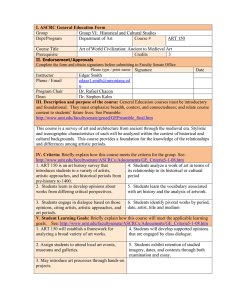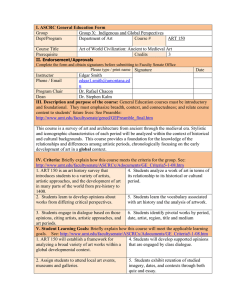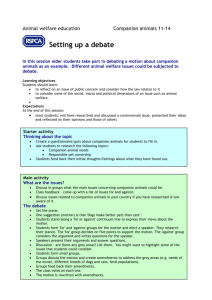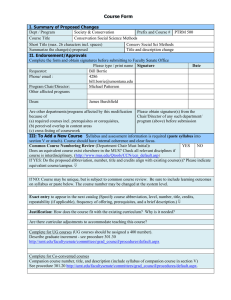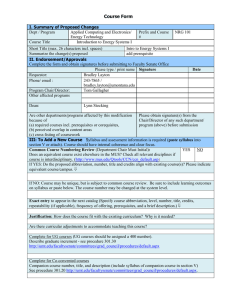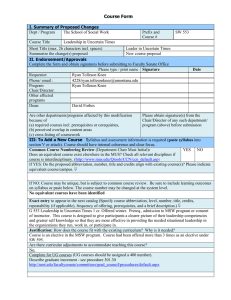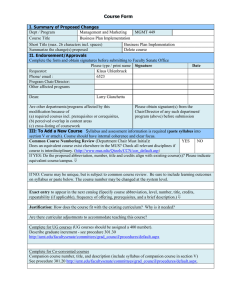Use to propose new general education courses (except writing courses),... renew existing gen ed courses and to remove designations for...
advertisement
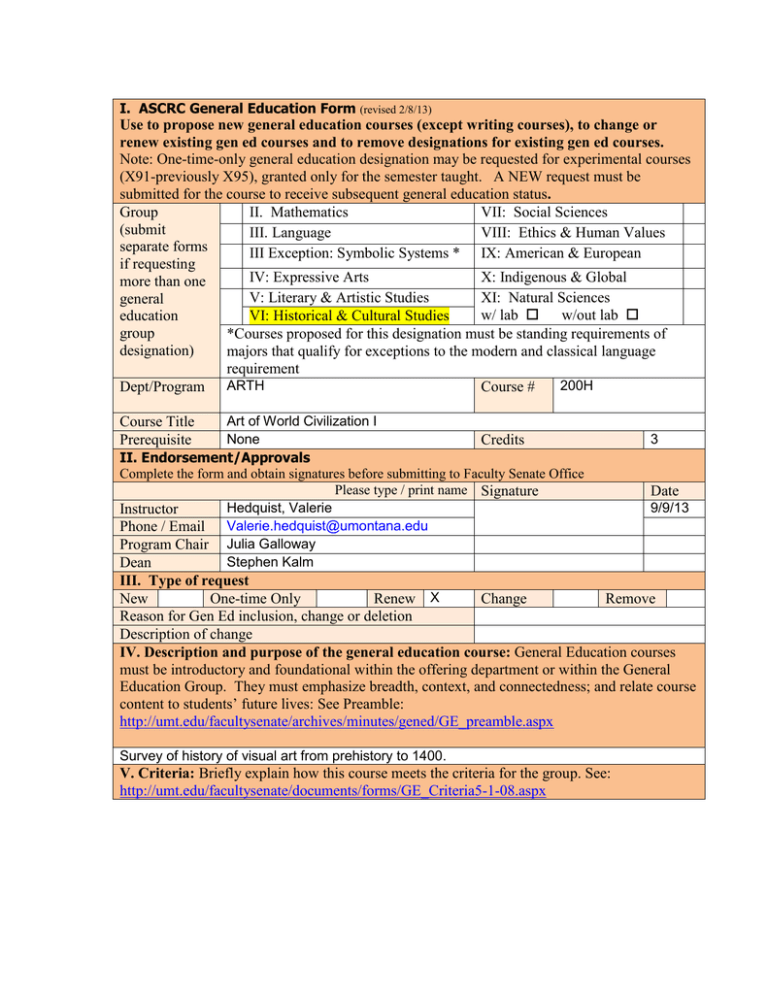
I. ASCRC General Education Form (revised 2/8/13) Use to propose new general education courses (except writing courses), to change or renew existing gen ed courses and to remove designations for existing gen ed courses. Note: One-time-only general education designation may be requested for experimental courses (X91-previously X95), granted only for the semester taught. A NEW request must be submitted for the course to receive subsequent general education status. Group II. Mathematics VII: Social Sciences (submit III. Language VIII: Ethics & Human Values separate forms III Exception: Symbolic Systems * IX: American & European if requesting IV: Expressive Arts X: Indigenous & Global more than one V: Literary & Artistic Studies XI: Natural Sciences general w/ lab w/out lab education VI: Historical & Cultural Studies group *Courses proposed for this designation must be standing requirements of designation) majors that qualify for exceptions to the modern and classical language requirement 200H Dept/Program ARTH Course # Art of World Civilization I None Credits II. Endorsement/Approvals Complete the form and obtain signatures before submitting to Faculty Senate Office Please type / print name Signature Hedquist, Valerie Instructor Phone / Email Valerie.hedquist@umontana.edu Program Chair Julia Galloway Stephen Kalm Dean Course Title Prerequisite 3 Date 9/9/13 III. Type of request New One-time Only Renew X Change Remove Reason for Gen Ed inclusion, change or deletion Description of change IV. Description and purpose of the general education course: General Education courses must be introductory and foundational within the offering department or within the General Education Group. They must emphasize breadth, context, and connectedness; and relate course content to students’ future lives: See Preamble: http://umt.edu/facultysenate/archives/minutes/gened/GE_preamble.aspx Survey of history of visual art from prehistory to 1400. V. Criteria: Briefly explain how this course meets the criteria for the group. See: http://umt.edu/facultysenate/documents/forms/GE_Criteria5-1-08.aspx Art objects and monuments produced from ancient through medieval times are considered through contextual analysis. Stylistic characteristics, artistic biographies, and iconographic interpretations provide the foundation for the study of the relationships and the differences among artistic periods. Art works are evaluated in terms of formal qualities (elements of art and principles of design) and examined as objects that communicate feelings and ideas. Social, political, economic, religious, and historical events are recognized as the context for art works. VI. Student Learning Goals: Briefly explain how this course will meet the applicable learning goals. See: http://umt.edu/facultysenate/documents/forms/GE_Criteria5-1-08.aspx Students attend image-based lectures with Moodle course supplement providing additional links and articles for review. Examinations require image identification and essay responses to questions. Hands-on projects also require students to analyze, synthesize, and evaluate works of art within a specific cultural context. VII. Justification: Normally, general education courses will not carry pre-requisites, will carry at least 3 credits, and will be numbered at the 100-200 level. If the course has more than one pre-requisite, carries fewer than three credits, or is upper division (numbered above the 200 level), provide rationale for exception(s). VIII. Syllabus: Paste syllabus below or attach and send digital copy with form. The syllabus should clearly describe how the above criteria are satisfied. For assistance on syllabus preparation see: http://teaching.berkeley.edu/bgd/syllabus.html ARTH 200 Art of World Civilization: Ancient to Medieval Art, 3 credits Survey of history of visual art from pre-history to 1400 Historical & Cultural Course, Non-Western Course Associate Professor Valerie Hedquist E-mail: valerie.hedquist@umontana.edu Course Description: Art objects and monuments produced from ancient through medieval times will be considered through contextual analysis. Stylistic characteristics, artistic biographies, and iconographic interpretations will provide the foundation for the study of the relationships and the differences among artistic periods. Learning Objectives: • analyze works of art and architecture as aesthetic objects • analyze works of art and architecture (examples of visual culture) as the products of a particular historical and cultural period • define the terminology (including key concepts and personalities) relevant to each section of the course • identify the key works by period, date, artist, title, and medium • understand the key works in terms of the issues • understand the changing role of art patronage • understand the changing role of the artist in society Required Text: Marilyn Stokstad, Art History, Vol. I (w/CD-ROM), revised, Prentice Hall, 2006. Website content: http://wps.prenhall.com/hss_stokstad_arthistrev_2 Requirements for Course: You are expected to attend class and participate. Students will utilize Moodle for course syllabus, other course materials, announcements, and grades. All assigned course work must be completed in order to earn credit for the class. Your grade will be calculated as follows: Two term examinations: 25% each, 50% total Two term projects: 10% each, 20% total Final examination, 30% Students with disabilities or special needs should see the instructor. Academic Misconduct and the Student Conduct Code: All students must practice academic honesty. Academic misconduct is subject to an academic penalty by the course instructor and/or disciplinary sanction by the University. All students need to be familiar with the Student Conduct Code. The Code is available for review online at www.umt.edu/SA/VPSA/Index.cfm/page/1321. Lecture and reading schedule: August 28, Introduction, What is art history? August 30, Prehistoric Art; Read text and explore companion website content: Chapter 1: Prehistory and Prehistoric Art in Europe September 4, Labor Day-no class September 6 and 11, Ancient Near Eastern Art; Read text and explore companion website content: Chapter 2: Art of the Ancient Near East September 13, Islamic Art; Guest lecture Tina Mills, Read text and explore companion website content: Chapter 8: Islamic Art September 18 and 20, Egyptian Art; Read text and explore companion website content: Chapter 3: Art of Ancient Egypt September 25 and 27, Aegean Art; Read text and explore companion website content: Chapter 4: Aegean Art Project #1 Due Date: September 27 October 2, 4, and 9, Greek Art; Read text and explore companion website content: Chapter 5: Art of Ancient Greece October 9, Term Examination #1 October 11, Indian Art; Guest lecture Tina Mills, Read text and explore companion website content: Chapter 9: Art of India before 1100 October 16, 18, and 23, Etruscan and Roman Art; Read text and explore companion website content: Chapter 6: Etruscan Art and Roman Art October 25, Jewish and Early Christian Art; Read text and explore companion website content: Chapter 7: Early Christian, Jewish, and Byzantine Art October 30, Byzantine Art; Read text and explore companion website content: Chapter 7: Early Christian, Jewish, and Byzantine Art Project #2 Due Date: October 30 November 1, 6 and 8, Art in Asia; Read text and explore companion website content: Chapter 10: Chinese Art before 1280 and Chapter 11: Japanese Art before 1392 November 8, Term Examination #2 November 13, Early Medieval Art; Read text and explore companion website content: Chapter 14: Early Medieval Art in Europe November 15 and 20, Romanesque Art; Read text and explore companion website content: Chapter 15: Romanesque Art Thanksgiving Break November 27, Art in Africa and the Americas; Guest lecture Tina Mills, Read text and explore companion website content: Chapter 13: Art of Ancient Africa and Chapter 12: Art of the Americas before 1300 November 29 and December 4 and 6, Gothic Art; Read text and explore companion website content: Chapter 16: Gothic Art Final Examination: Please note: Approved general education changes will take effect next fall. General education instructors will be expected to provide sample assessment items and corresponding responses to the Assessment Advisory Committee.
